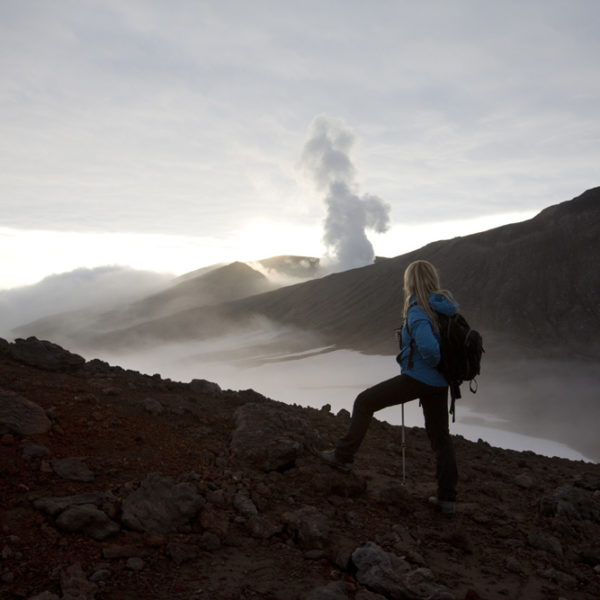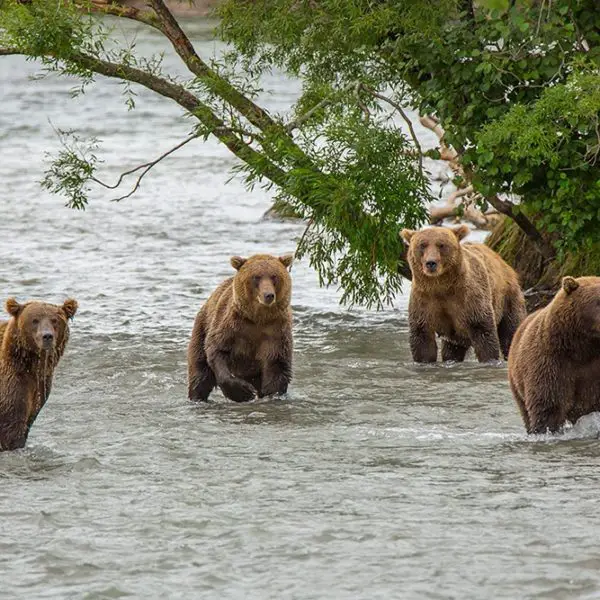The Essential Kamchatka Travel Guide
If you’re the type of traveller who tends to avoid the well-trodden path in search of one-of-a-kind adventure experiences, Kamchatka should be at the top of your bucket list. We are proud to share this essential Kamchatka travel guide with you, enjoy the journey!
Kamchatka is a 1,250km (780 miles) long peninsula in Russia’s far east, geographically closer to Alaska than to Moscow. Due to its remoteness, the peninsula is rarely visited by foreigners, yet the region has an immense amount to offer determined travellers, including over 300 volcanoes (29 of which are still active). But Kamchatka isn’t all just impenetrable mountains and barren lava fields. The landscape is a mosaic of tundra, deciduous forest and pristine waterways, while its Pacific coastline supports a remarkable abundance of wildlife. One of the reasons Kamchatka has such a well-preserved natural environment is because less than 400,000 people inhabit the entire peninsula. In 1991, after the collapse of the Soviet Union, Westerners and other outsiders were permitted for the first time in over half a century to visit Kamchatka, one of the most mysterious regions of the former Soviet empire. Kamchatka isn’t the easiest place to get to, but that’s what makes it so special.
Below we’ve revealed some of the peninsula’s most spectacular natural attractions, proving that Kamchatka is the ultimate adventure travel destination.
Table of Contents
Kluchevskoy Nature Park
Included in the UNESCO World Heritage site – “Volcanoes of Kamchatka“, Klyuchevskoy Nature Park in Eastern Kamchatka, covers an area of 376,000 ha with Eurasia’s most grand and active Klyuchevksaya group of volcanoes in its centre. It consists of 13 volcanoes, including 4 active: Klyuchevskay Sopka, Plosky Tolbachik, Besymyanny, Ushkovsky; and 9 extinct ones: Kamen, Krestovsky, Ostry Tolbachik, Ovalnaya Zimina, Ostraya Zimina, Bolshaya Udina, Malaya Udina, Sredny, and Gorny Zoub.
With Kamchatka’s largest river running through it, the park is unique for its dense concentration of giant volcanoes over a relatively small area, attracting scientists, photographers, trekkers and mountain climbers from all around the globe. Getting to the park is not so easy, with a full day drive (550 km /10-12h) from Paratunka to Kozyrevsk village, with overnight there in wooden cabins or in tents; and additional short drive (2-3h) on the next day in order to reach Klyuchi village. The route is on unsealed and bumpy roads, but it really worth it!
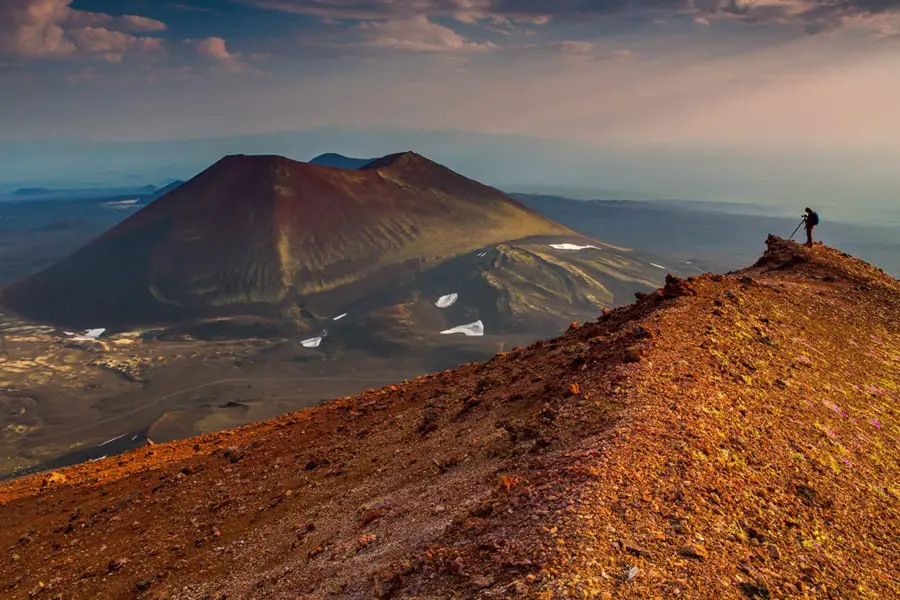
Located in the centre of Klyuchevksoy Nature Park, Kluchevskaya Sopka volcano (4,750m) is the highest in Eurasia. With its steep, symmetrical cone, covered with snow throughout the year, it’s one of the park’s most photogenic sites. It is a cone-shaped volcano, that can be climbed from all sides. The tours organised only for experienced alpinists are usually 7-10 days duration (including transfers to the park and back), and they include not only ascending Klychevsakaya Sopka volcano but also trekking the glaciers.
Recent Klyuchevskaya eruptions took place in 2007, 2010, 2012, 2013 and 2015, offering amazing photo opportunities and breathtaking views.
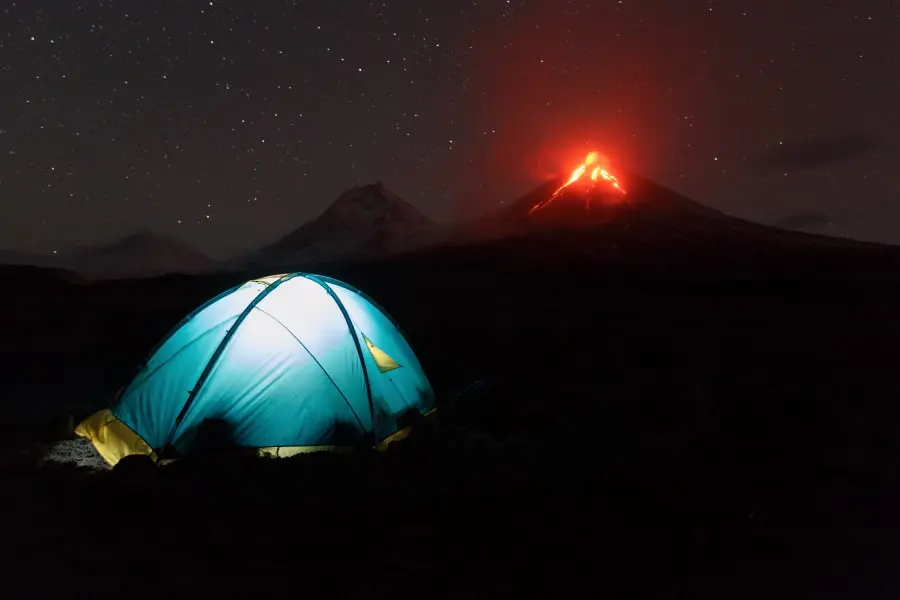
Tolbachik volcano, its lava fields and the “Dead forest”
Another volcano, located inside Klyuchevskoy Nature Park is Tolbachik, one of the most photogenic volcanoes of Kamchatka. Tolbachik is a volcanic complex, consisting of two volcanoes: Plosky (flat) and Ostry (sharp). Although the most recent major eruption took place in 1976, minor eruptions occurred in 2012 and 2013. Daredevil photographers positioned near the crater were able to capture awe-inspiring images of the spurting lava.
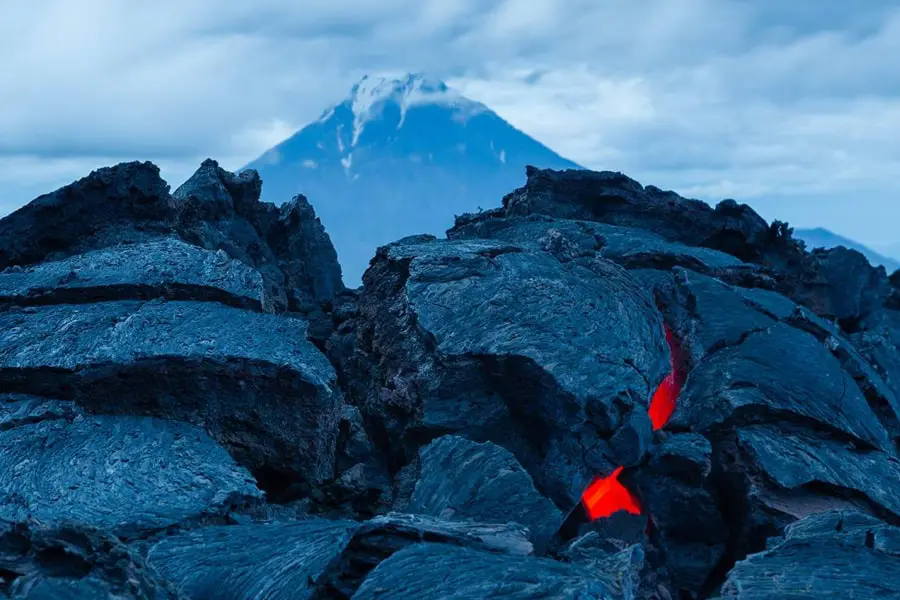
The 1976 Great Eruption devastated the forests at the base of Tolbachik. Today, the area is known as the Dead Forest, an eerie wasteland skeleton-like trees that looks like a scene straight out of Mordor.
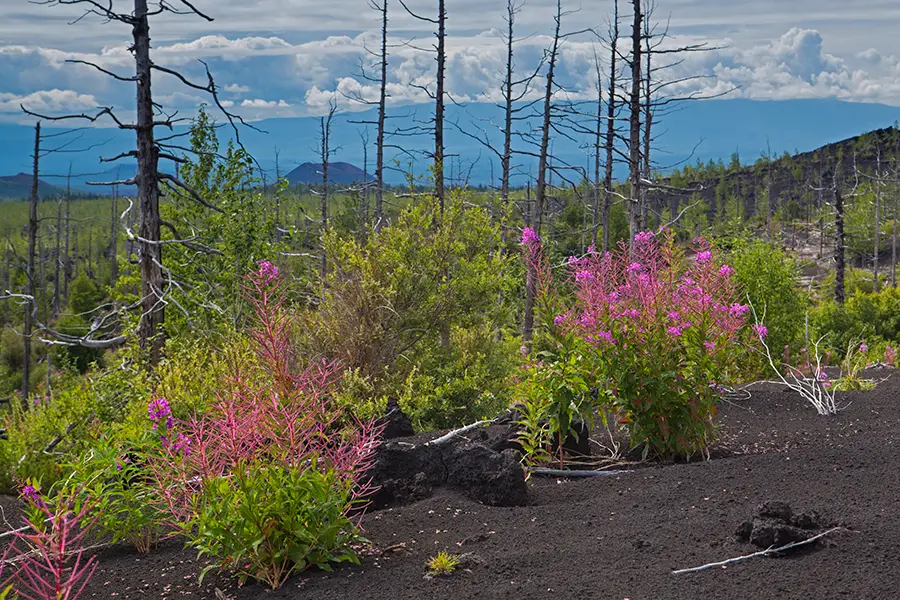
The following tours offer a visit to Klyuchevskoy Nature Park: Trekking volcanoes of Kamchatka from North to South, Kamchatka’s Critters and Craters and Kamchatka – The Lost World. All of them have just several guaranteed departure per year (July-August), so keep it in mind when planning to join one of them, as they get sold out quite quickly.
Esso village and reindeer herders
Located 520km from Petropavlovsk and nestled in a valley surrounded by mountain ridges and evergreen forests, Esso is one of the best places to get acquainted with the lives of Kamchatka’s local people. Esso’s gorgeous scenery has led to it being described as the ‘Switzerland of Kamchatka’. It’s a laidback place, populated by about 2,500 people, with hot thermal pools and a network of hiking trails extending into the neighbouring Bystrinsky Nature Park.
Located relatively close to Klyuchevskoy Nature park, the village is a good “stop” on a tour, to relax in hot thermal pools after a long stay in the wild and trekking active volcanoes.
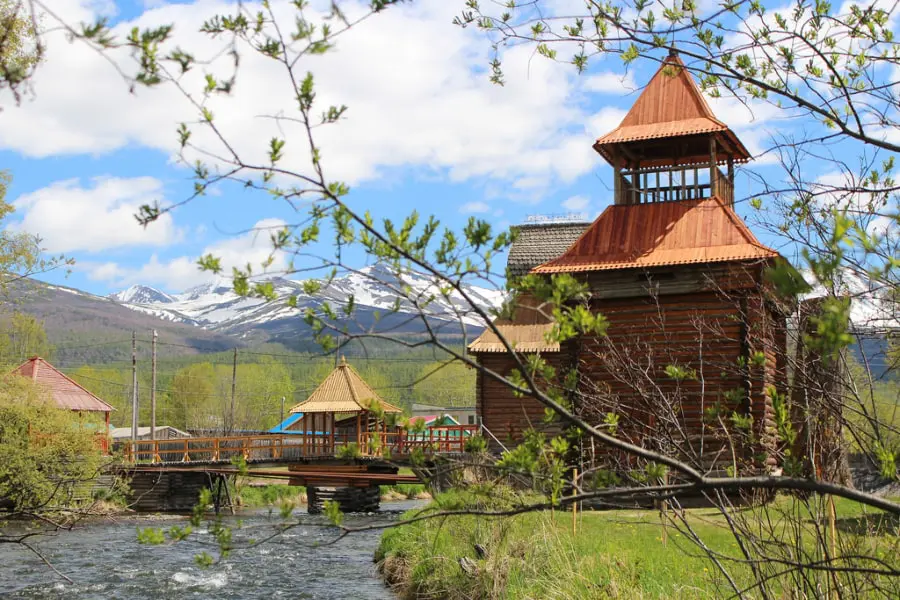
From here, the groups can reach reindeer herders by helicopter. It takes 1 to 2 hours (based on the reindeer herders current location) of picturesque flight, after which a group may spend 2-3 hours (or even a day) in the camp to see the semi-nomadic way of life of indigenous Kamchatka people. Have a look at the Kamchatka’s Critters and Craters tour or Kamchatka – The Lost World tour which includes this experience.
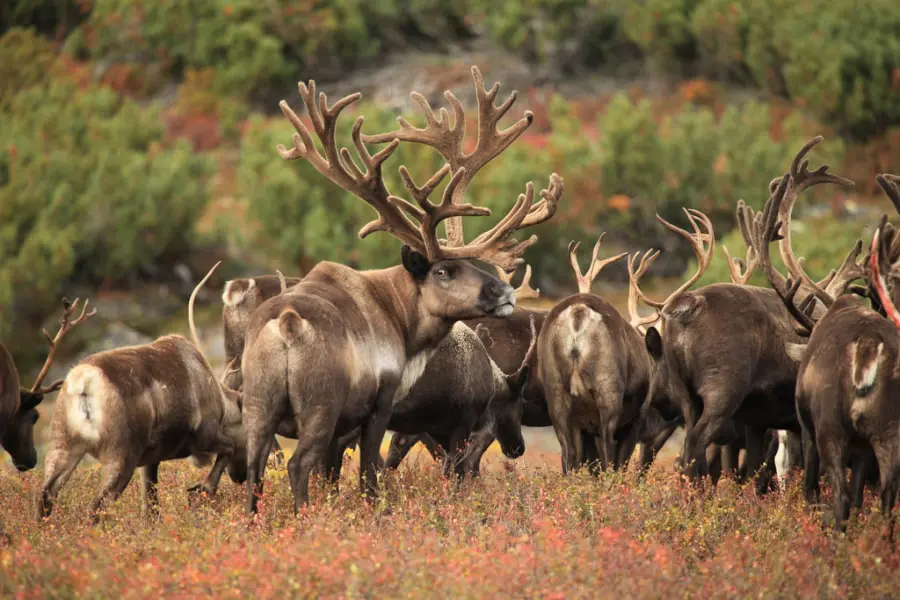
Valley of Geysers
Home to the second-largest concentration of geysers the world, this valley’s bizarre scenery appears thoroughly prehistoric, with around 90 steaming geysers that periodically expel huge volumes of hot water in spectacular skyward jets. Only accessible by helicopter, and requiring guides and a network of boardwalks to provide a safe passageway between the frequently erupting vents, this natural gem remains a virtually untouched region of raw geothermal power.
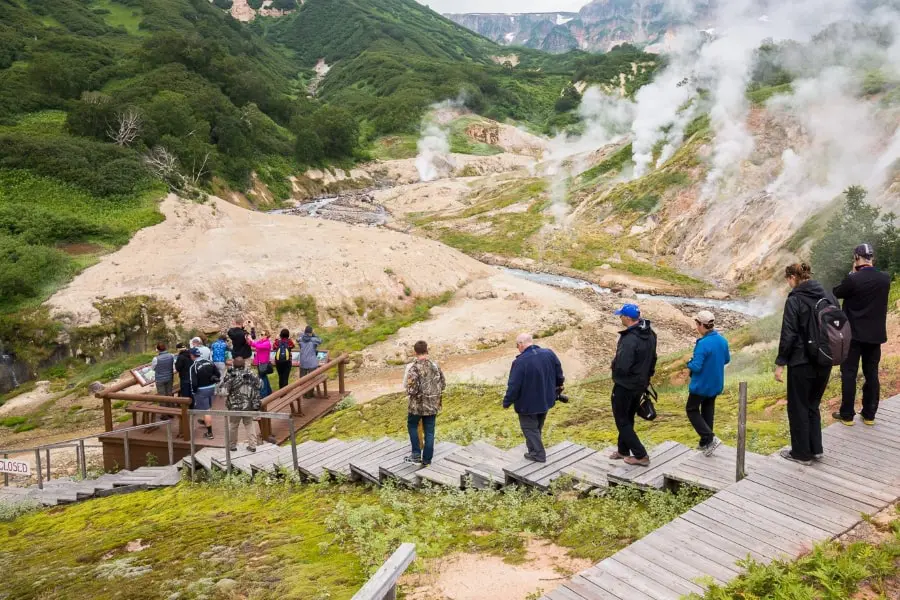
The several flights a week, organized from a helipad located close to Paratunka village, take place from July to September. You will join other travellers, boarding MI-8 helicopter. The tour duration is appx 8 hours on which you will not only enjoy a scenic trek in the valley but also will land in Uzon Caldera for breathtaking shots of steaming vents. Almost all tours in Kamchatka includes this site, however, it usually marked as optional, due to quite a high price (approx US $650pp).
Kurilskoye Lake
Kurilskoye or Kuril Lake is a crater lake at the southern tip of Kamchatka Peninsula. The lake and its surrounds are renowned among wildlife lovers as being the largest spawning ground for sockeye salmon in Eurasia. As millions of salmon swarm the lake between July and September, hundreds of brown bears take the water to gorge themselves on the fishy feast. The phenomena give visitors the opportunity to observe the bears at a remarkably close range.
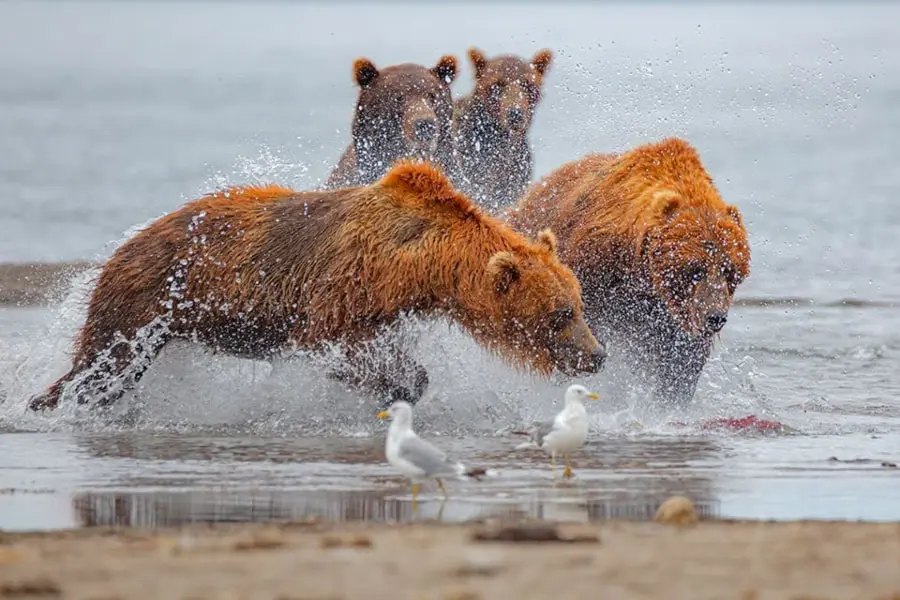
There are a couple of options, which allows you to visit the lake and enjoy brown bears watching:
1. Day-tour with a combined group of travellers by MI-8 helicopter
The 5-hours tour has a fixed number of stops (Kuril lake, the caldera of Ksudach volcano, Khodutka hot springs) and includes meals and bathing in hot springs.
2. Multi-day stay on the lake
For travellers who desire to immerse themselves in the kingdom of brown bears, the option of staying at the Kuril lake’s base camp might be worth considering. This is possible by securing one of the package tours, such as The Kingdom Of Brown Bears, Critters and Craters or Kamchatka – The Lost World, which usually consists of 16 people and also include trekking active volcanoes and other activities.
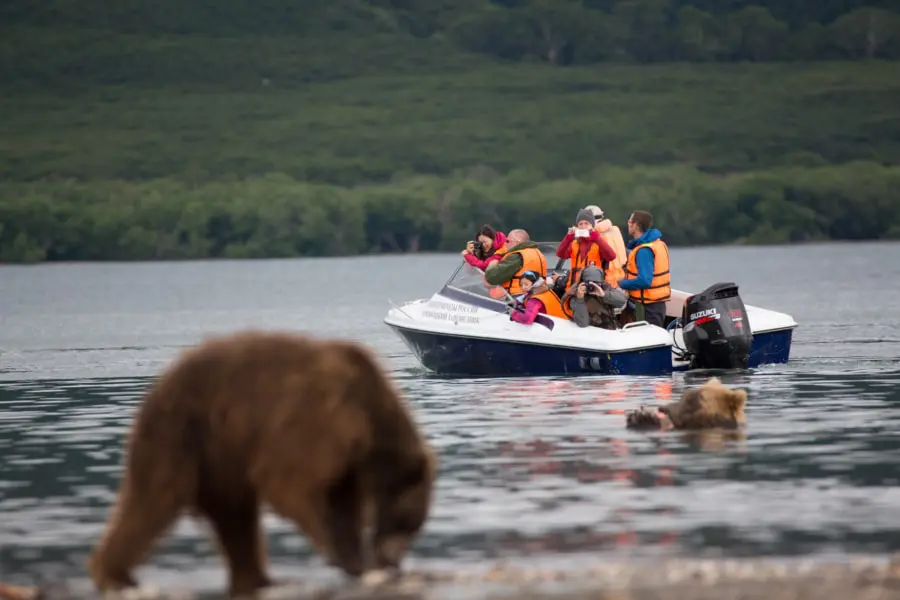
Mutnovsky and Gorely volcanoes
Located on the Pacific ‘Rim of Fire’, Kamchatka is home to over 300 volcanoes. Mutnovsky is one of the most active. Near its 2,322m summit is a nest of merged craters and brilliant blue glacial lakes. On a hike to the summit, you will see hissing fumaroles surrounded by bright yellow sulphur crystals.
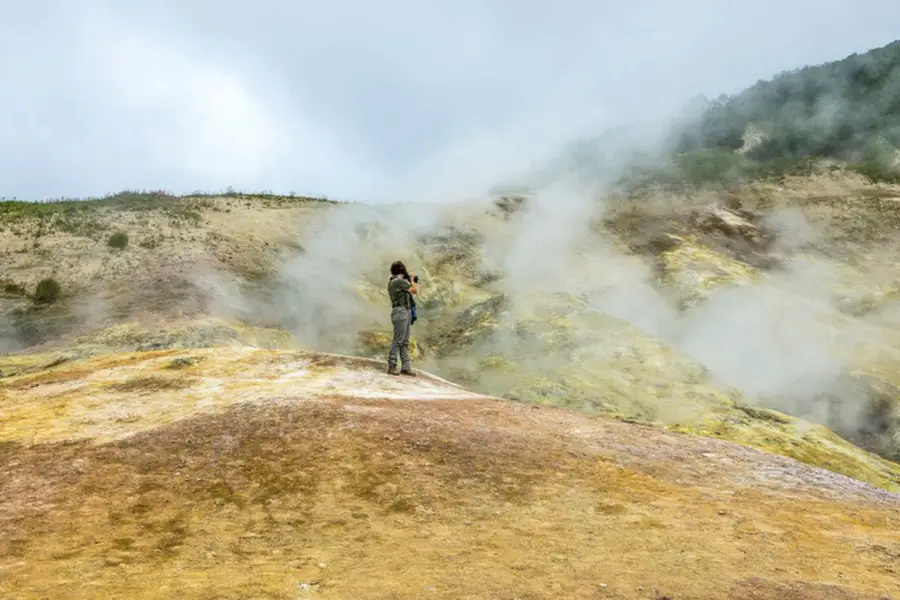
At the foot of Mutnovsky volcano is one of Kamchatka’s hidden jewels, the Mutnovsky ice caves. A group of photographers found these caves by chance in late 2012. The caves can be explored in Summer month, but it highly depends on the weather and snow conditions, as sometimes the “gates” to the caves can be covered by heavy snow, not allowing travellers to enter these fairytale sites.
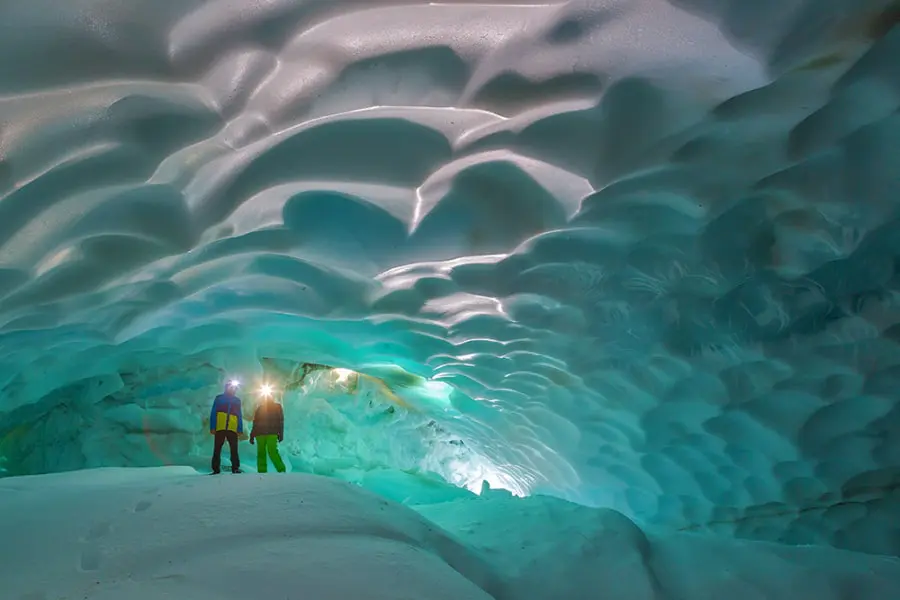
North of Mutnovsky is Gorely, another extremely active volcano known for its striking turquoise lake of hot sulphuric acid. Both volcanoes can be submitted via moderately strenuous, full-day hikes.
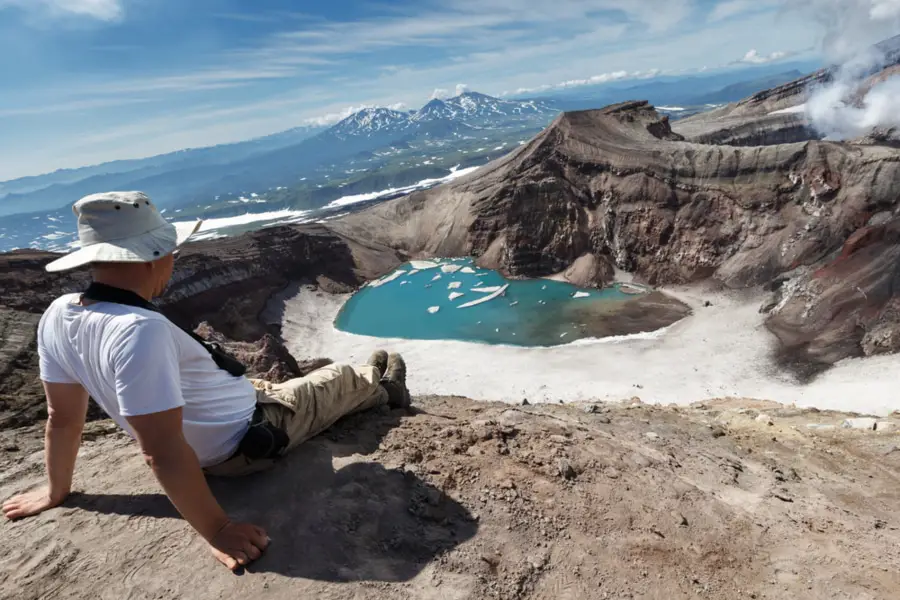
Because of they’re geographical relatively, trekking of both volcanoes is usually combined in 2-3 days tour. The scenic route to the volcanoes takes about 4-5 hours by 6WD truck from Petropavlovsk or Paratunka, with an optional stop at Vilyuchinsky Pass and at a majestic waterfall at Opasny Canyon.
Check out the Trekking volcanoes of Kamchatka tour or Kamchatka – The Lost World tour in order to hike Mutnovsky and Gorely volcanoes.
Avacha Bay, Starichkov Island and Russkaya Bay
In addition to the trekking and wildlife watching tours, which take you into the wilderness of Kamchatka, there are also several essential Kamchatka seaside trips that any passionate traveller should take.
Stunning Avacha bay (or Avachinskaya) is considered to be among the largest and most beautiful bays in the world, offering the picturesque panorama from the sea, fairly close to the capital of the peninsula.
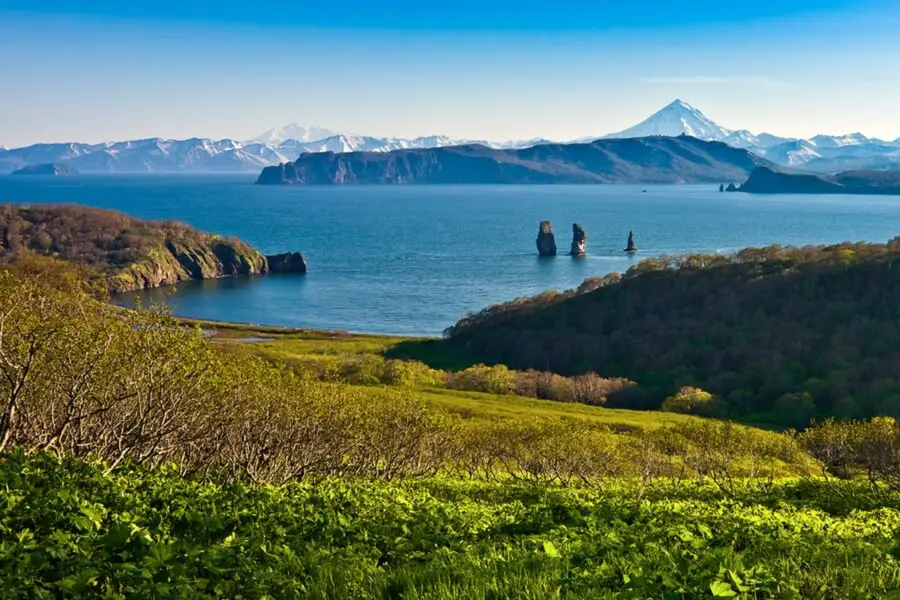
Located close to Avacha Bay, a very small and rocky Starichkov Island, is a splendid natural wonder, which houses massive bird colonies that have determined its designation as a nature reserve.
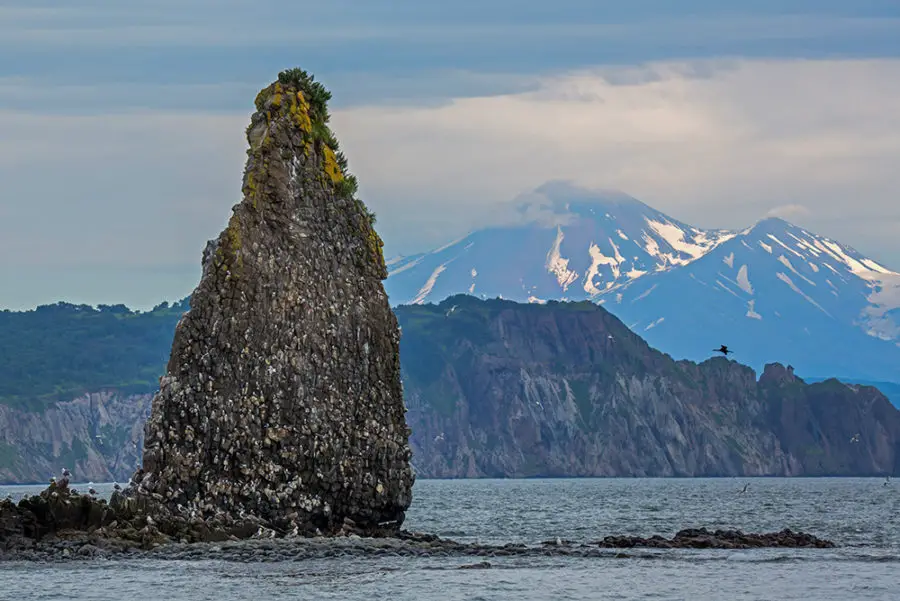
South of Petropavlovsk-Kamchatsky is scenic Russkaya Bay, a narrow fjord-like bay with a rugged, rocky coastline backdropped by snowy mountain peaks. Russkaya is one of the most pristine pockets of Pacific wilderness in the area and is home to an incredible variety of marine mammals including whales, orcas, sea lions and otters.
Russkaya Bay is best experienced by a full day cruise from Petropavlovsk seaport. You first pass Avacha Bay and enjoy the bird life at the Starichkov Island, before heading to Russkaya.
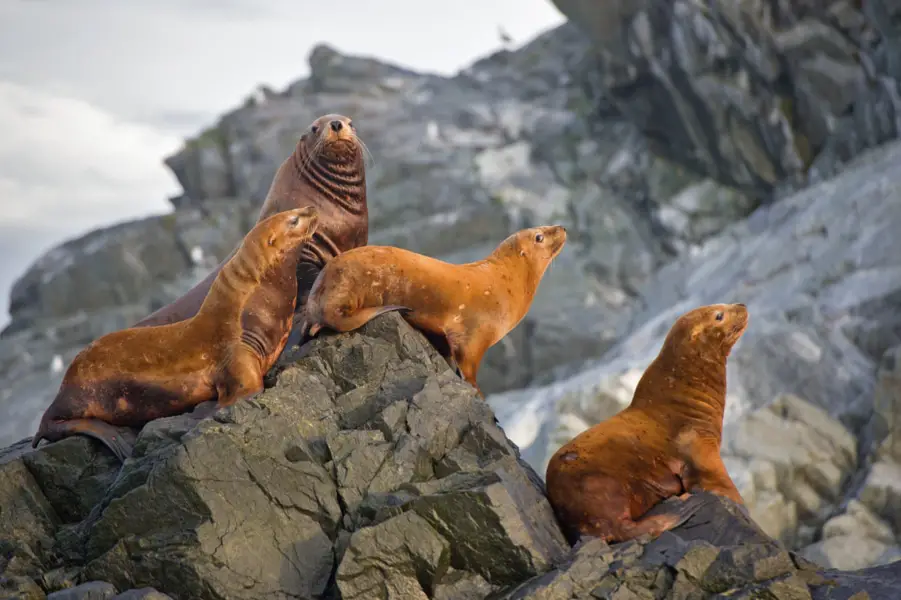
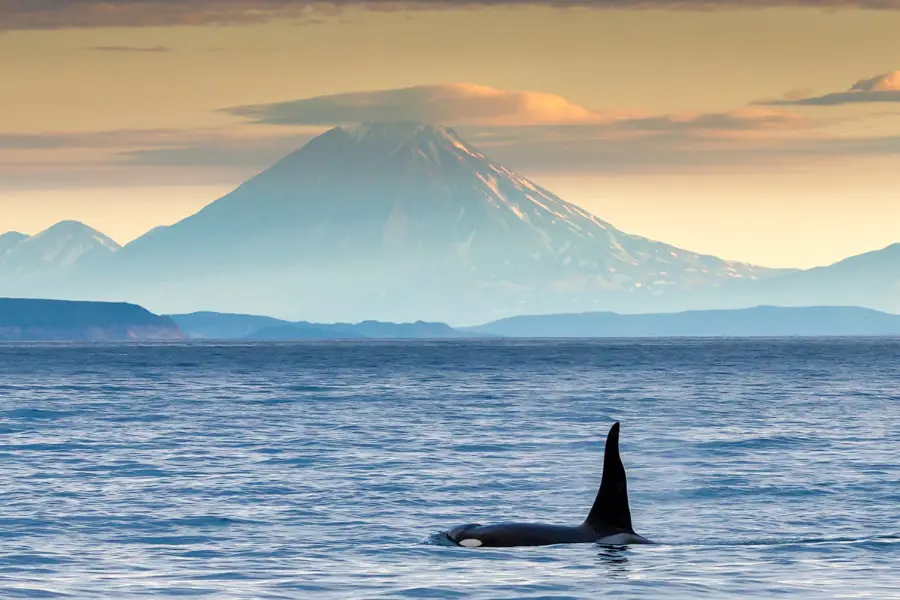
Hot springs
Fed by the thermal energy of Kamchatka’s volcanoes, hot springs are dotted across the peninsula, particularly in the south of the peninsula. Many of them enjoy picturesque settings, nestled in forested alpine valleys or surrounded by towering peaks. The warm waters of these natural spas are rich in minerals. Bathing in them is said to have health benefits such as improving circulation and metabolism, nourishing the skin and providing relief from ailments such as arthritis and high blood pressure.
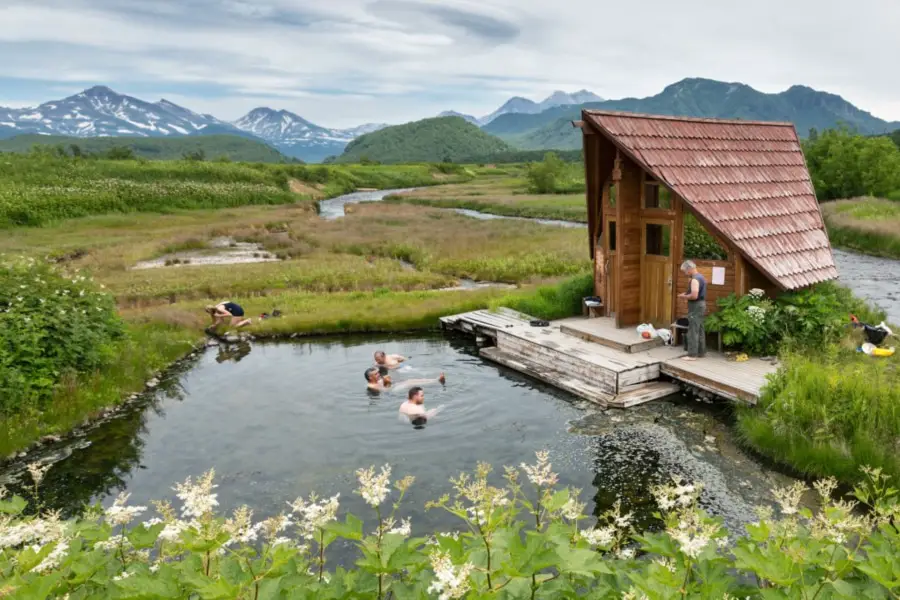
Most popular hot springs in Kamchatka are Malki, Verkhne-Paratunskie, Vilyuchinskie, Nalychevo and Khodutka. The last one is the most beautiful and wild one it can be reached only by helicopter on the Kingdom of Brown Bears tour. Others hot springs are included in most Kamchatka tours, after half-day trekking and hikes.
Avachinsky volcano
Towering above Petropavlovsk-Kamchatsky, Avachinsky (2,741m) is one of five volcanoes visible from the city. Amazingly, it is one of the most active volcanoes in the region, although its recent eruptions have been small and posed no threat to the townspeople. With its perfectly conical shape, Avachinsky is considered one of the most beautiful volcanoes in Kamchatka. The climb to the top is relatively straightforward and can be achieved in a day, making it popular with local and visiting hikers in good weather. On a clear day, the view from the summit is a breathtaking panorama over the Petropavlovsk chain of volcanoes.
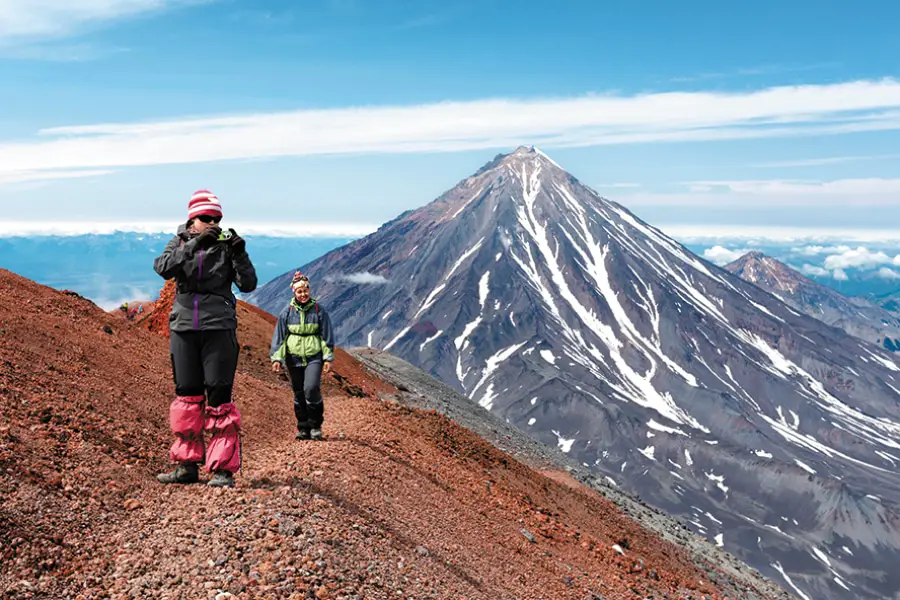
The hike is very long and challenging (up to 10h), however, no special skills or gear is involved. Usually, groups stay at the base camp at the foot of the volcano for overnight, with a training hike to Camel mountain on the first day and Avachinsky volcano ascending on the second day. However, this hike also can be done just in 1 day, after which you get back to the hotel and rest in the hot thermal pool. Check the Kamchatka Discovery tour or Trekking volcanoes in Kamchatka from North to South tour, which include the Avachinsky volcano ascending.
Vachkazhets Mount
Located in 80km to the west of Petropavlovsk-Kamchatsky, Vachkazhets included in the system of the Uzhno-Bystrinsky range. Vachkazhets and its surroundings are among the most beautiful spots in Kamchatka, telling a story stretching back to ancient times when Vachkazhets was a one-cone volcano before exploding and dividing into three parts. You will be able to take in the scenic surrounds and appreciate the serene quiet at a picnic lunch during the trek.
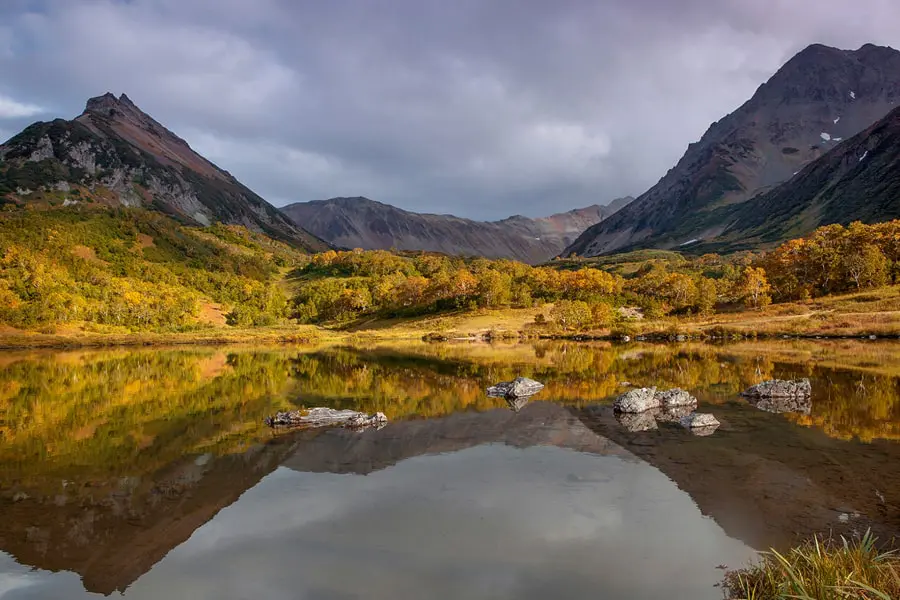
Khalaktyrsky (Black) beach
A remote Siberian territory sounds like the last place on earth to emerge as a surf destination, but that’s exactly what’s happening at Khalaktyrsky Beach, a vast expanse of black sand with monumental volcanoes in the background.
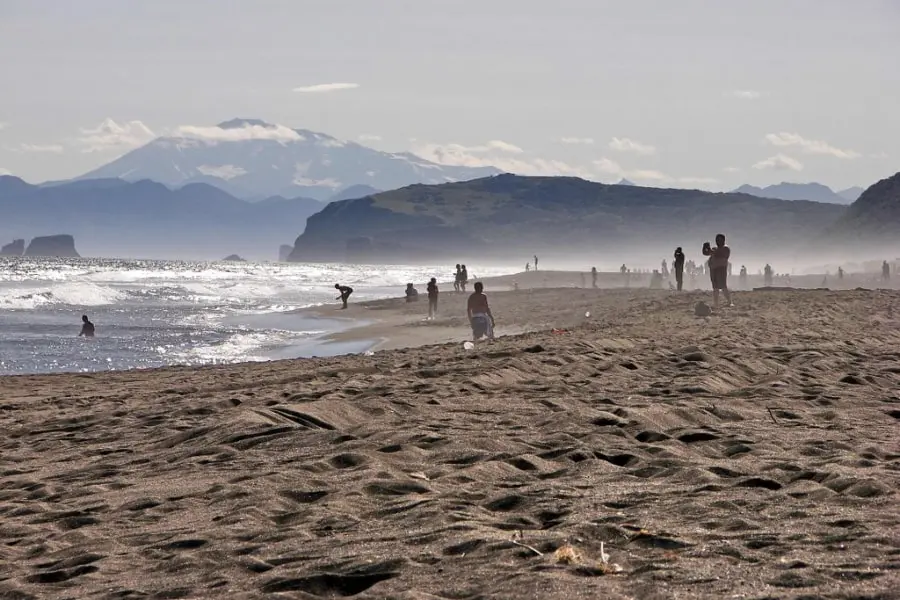
The waves here can reach an epic 5.5m. In summer, Khalaktrysky transforms into a surf camp of tents and open fires, as hardcore wave chasers brave the frigid +10C degree water in search of the perfect break. A few brave souls even surf the snow-covered beach in winter, when the ocean temperature is a bone-chilling 2C. Despite this, it’s becoming a new destination for world-renowned surfers.
Winter sports
If you are an experienced skier with a taste for the extreme, then you would have a field day during the winters of Kamchatka. The action starts with an airlift to the volcanic region in a Russian MI-8 helicopter. When you get to the skiing destination, you would touch down in the middle of nowhere and get a free ride down the active volcanoes. If you are up for more adventure, you can ski into the crater of Mutnovksky volcano, with all the terrific vents seething around you.
There are several departures for heli-skiing tours about 7-10 days duration in total, which can be combined with backcountry-skiing or even sailing-backcountry.
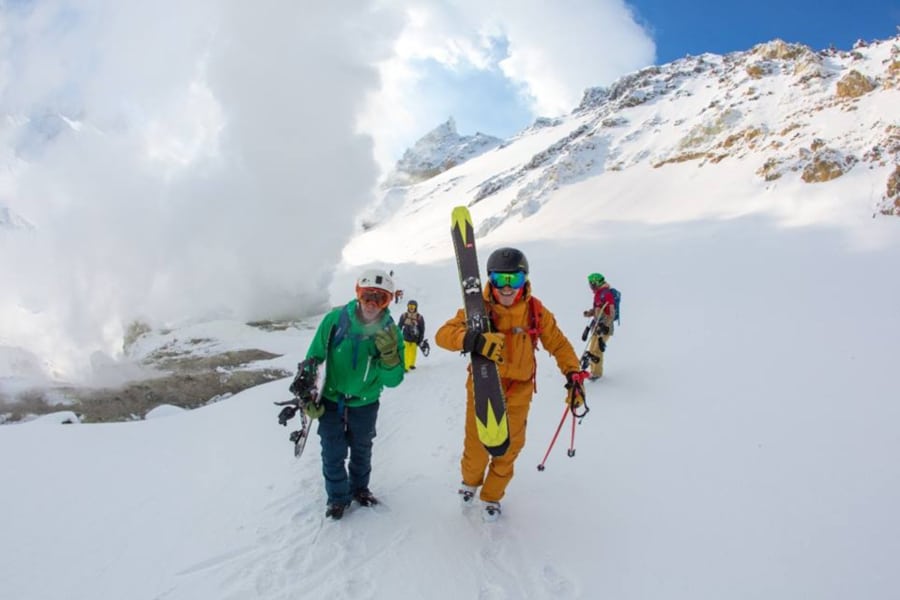
For adventurers who prefer more of a “calmer pace” of travelling, there are plenty of opportunities to enjoy snowmobiling and dog sledding around the beautiful natural landmarks of Kamchatka. Check the Winter Adventure in Kamchatka tour, if you are looking for this experience.
Kamchatka Travel Guide – Logisistics
How to get there
Kamchatka is a relatively remote place, this is why it has such a rich wildlife and wilderness environment. The only way to get to Kamchatka is by air. The airport of Petropavlovsk-Kamchatsky is about 20 km from the capital in the village of Yelizovo. The airport receives daily direct overnight flights from Moscow and occasional flights from Russian major cities like St Petersburg, Vladivostok and Khabarovsk. During summer months there are occasional international direct flights operate from Tokyo, Japan (July) and Anchorage, Alaska (July – August). Check Aeroflot and S7 airlines to find the best connections.
Best time to visit
Summer is the best time to visit Kamchatka for trekking tours, photography tours and wildlife watching. Choose any time from the beginning of July until mid-September.
During the winter and spring, the bears would be in hibernation making it impossible for you to see them do their thing. However, during this season, you have a chance to see the rich landscape in all its natural beauty by embarking on skiing, heli-skiing or other winter adventure tours around Kamchatka. If you don’t scare of below-zero temperatures choose January – April for your winter adventure in Kamchatka.
Shoulder season months: end of October-December and May-mid-June, are not recommended for travelling.
Hope you enjoyed reading this article and you found it useful. If you ready to embark on Kamchatka adventure, just choose one of our scheduled group tours. For more information about Kamchatka or travelling to Russia in general, please contact us at [email protected].
Related posts
Related Tours
If you have any urgent questions or enquiries, please give us a call +61 412 587 785

